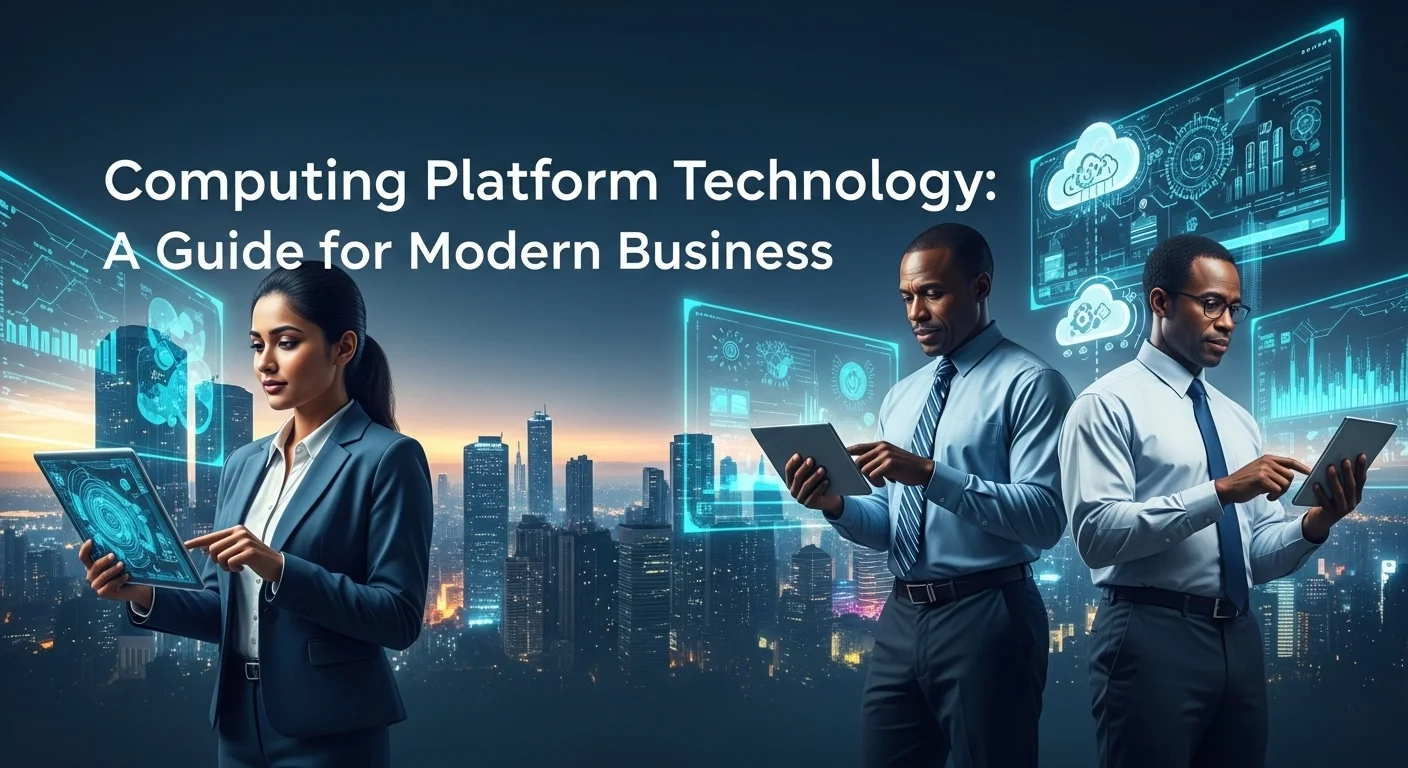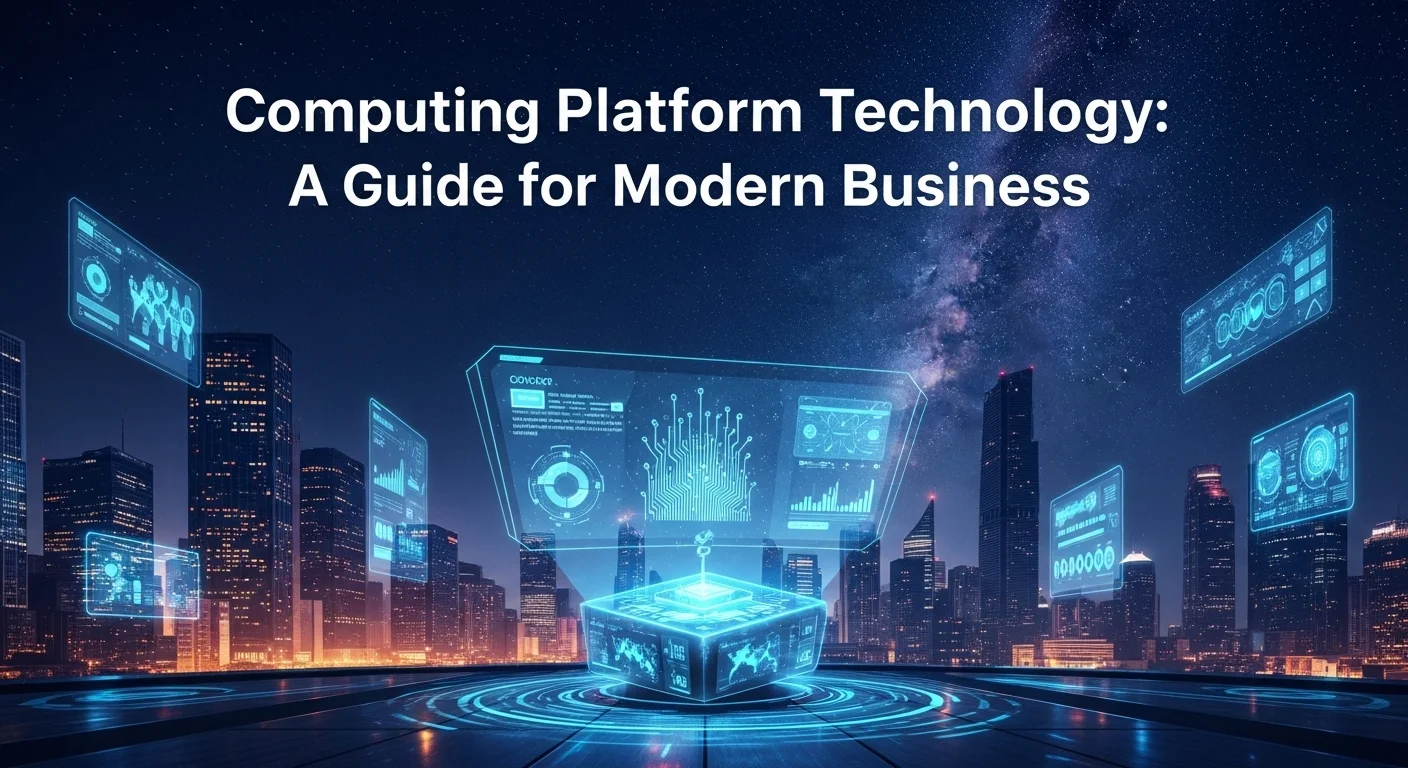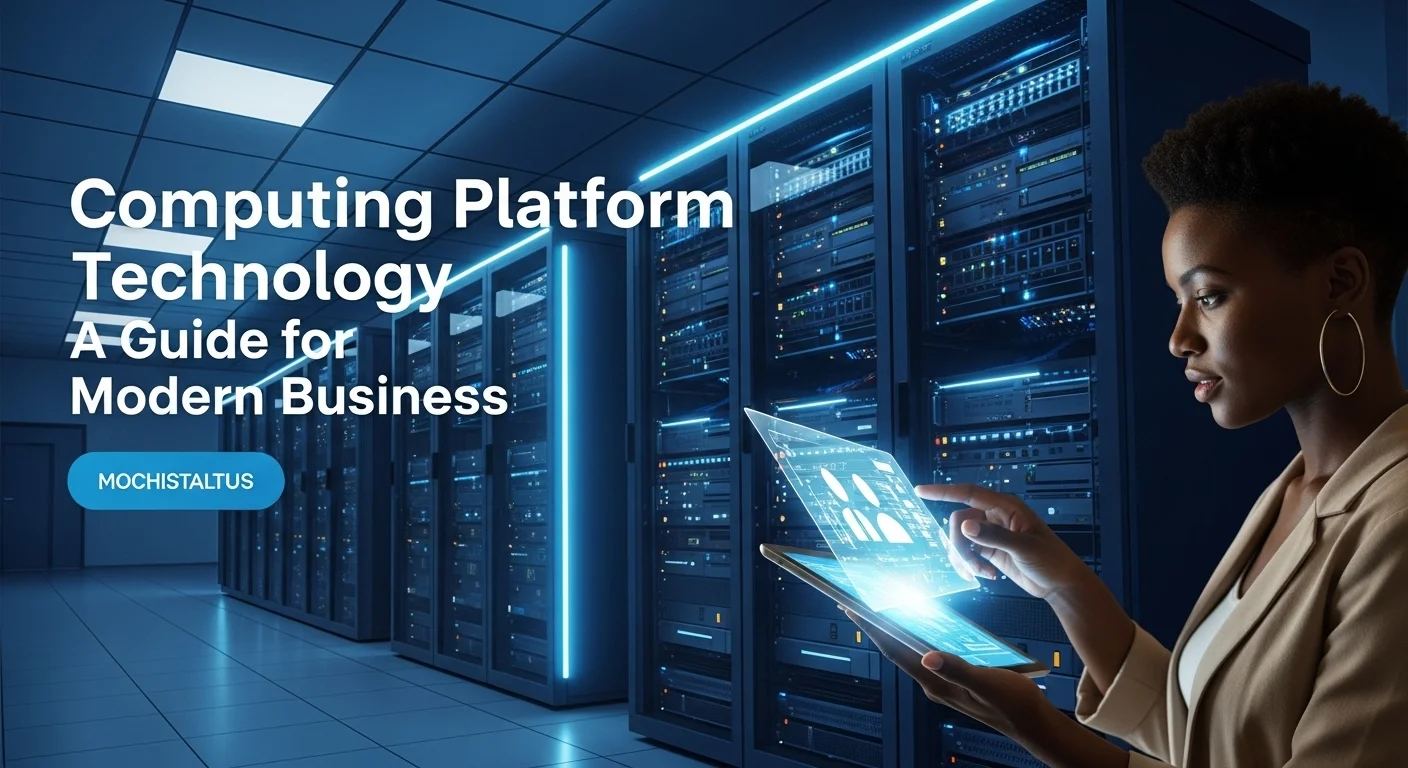Computing Platform Technology: A Guide for Modern Business

Executive Summary
In the digital age, the term 'computing platform' is fundamental to all technological endeavors. It represents the very ground upon which software and applications are built and executed. Understanding the different types of computing platforms is no longer just for IT specialists; it's a strategic imperative for business leaders, entrepreneurs, and tech enthusiasts. From the immense power of a high performance computing platform used in scientific research to the agile and cost-effective nature of a serverless computing platform that powers modern web applications, the choice of platform has profound implications on scalability, performance, and cost. This article delves into the critical world of the compute platform, demystifying complex concepts like the unified compute platform and high computing platform models. We will explore their importance, compare their architectures, and provide a strategic guide for selecting the right solution to drive innovation and efficiency in your business operations. Grasping these concepts is key to unlocking technological potential and securing a competitive edge.
Table of Contents
What is Computing Platform and why is it important in Technology?
In the vast and ever-evolving landscape of information technology, the term 'computing platform' serves as a foundational concept, yet its true meaning can often feel abstract. At its core, a computing platform is the environment in which a piece of software is executed. [4] It is the combination of hardware and software architecture that provides the necessary services for an application to run. [1, 2] Think of it as the stage and backstage of a theater; the audience sees the play (the application), but behind the scenes, there is a complex interplay of lighting, sound systems, stagehands, and structures (the platform) that makes the performance possible. This environment isn't just a single layer; it's a stack of technologies. It starts with the physical hardware—the processors (CPUs), memory (RAM), and storage—and extends to the operating system (OS) like Windows, macOS, or Linux, which manages these hardware resources. [4, 13] On top of the OS, there are runtime libraries and frameworks that provide common functionalities for applications. The choice of a compute platform is one of the most critical decisions in technology and business strategy, as it directly influences everything from development speed and application performance to scalability, security, and total cost of ownership. The right platform can act as a powerful catalyst for innovation, while the wrong one can become a significant bottleneck.
The Evolution of Computing Platforms
The concept of a computing platform has evolved dramatically over the decades, mirroring the broader progress of technology. In the early days of computing, platforms were monolithic mainframes—large, centralized systems that handled all processing tasks. As technology progressed, the client-server model emerged, distributing tasks between a central server and multiple client computers. The personal computer (PC) revolution brought computing power to individual desks, establishing operating systems like MS-DOS and later Windows as dominant platforms. The rise of the internet ushered in the era of web platforms, where applications run within a web browser, abstracting away the underlying OS to a certain extent. Today, we are in the era of cloud and distributed computing. Modern platforms are often not tied to a single physical machine but are distributed across vast data centers owned by cloud providers like Amazon Web Services (AWS), Microsoft Azure, and Google Cloud Platform (GCP). [3, 26] This shift has given rise to powerful and flexible platform models that cater to a wide array of needs, from startups to global enterprises. Understanding these modern platform types is essential for navigating the current technological landscape.
The Strategic Importance for Business
For any business operating in the 21st century, technology is not just a support function; it is a core driver of value. The computing platform underpins all digital initiatives, from the company website and mobile apps to internal enterprise resource planning (ERP) systems and customer relationship management (CRM) software. The strategic importance of selecting the right compute platform cannot be overstated. A scalable platform allows a business to handle sudden surges in demand, such as an e-commerce site during a holiday sale, without crashing. [41] An efficient platform helps in reducing operational costs, directly impacting the bottom line. [25] A secure platform protects sensitive customer data and intellectual property, which is crucial for maintaining trust and complying with regulations. Moreover, a flexible and modern platform enables developers to build and deploy new features faster, fostering innovation and helping the business stay ahead of the competition. [25] It's a decision that impacts agility, resilience, and the overall capacity for growth.
Deep Dive: High Performance Computing Platform (HPC)
When standard computing power is not enough, organizations turn to a high performance computing platform (HPC). HPC refers to the practice of aggregating computing power in a way that delivers much higher performance than one could get out of a typical desktop computer or server. [5] Think of it as the difference between a single musician and a full orchestra. By combining the power of thousands of processors working in parallel, HPC systems can tackle immensely complex computational problems. [19] These are often referred to as supercomputers. The core components of an HPC architecture include compute nodes (the individual servers), a high-speed network to connect them (like InfiniBand), and a high-performance storage system that can feed data to the processors at an incredible rate. [5] The entire cluster is managed by a scheduler, which allocates jobs and resources efficiently. [19] A high computing platform like this is indispensable in fields such as scientific research (e.g., climate modeling, genomic sequencing, particle physics), engineering (e.g., simulating car crashes or airflow over an airplane wing), and finance (e.g., running complex risk analysis models). [22, 5] With the advent of cloud computing, access to HPC has become more democratized. Companies can now rent supercomputing power from cloud providers, making this powerful technology accessible without the massive upfront investment in hardware. [22]
Deep Dive: Serverless Computing Platform
At the other end of the spectrum in terms of management overhead is the serverless computing platform. The name is slightly misleading; of course, there are still servers involved. [21, 33] The 'serverless' aspect refers to the fact that developers no longer have to worry about provisioning, managing, or scaling those servers. [15, 32] The cloud provider handles all of that automatically. The most common model for serverless is Function-as-a-Service (FaaS). [11, 33] In this model, developers write small, single-purpose pieces of code called functions. These functions are designed to execute in response to specific events or triggers. [7, 14] For example, an event could be a user uploading an image to a storage service. This event triggers a function that automatically resizes the image into different formats. The beauty of a serverless computing platform lies in its efficiency and scalability. You only pay for the compute time you actually consume—down to the millisecond. [11] When a function is not running, you pay nothing. [21] When demand spikes and a function needs to be executed thousands of times per second, the platform scales automatically to handle the load without any manual intervention. [32] This makes it an incredibly cost-effective and agile model for building event-driven applications, APIs, and microservices. However, it also has its own set of challenges, such as potential vendor lock-in and 'cold starts,' where a function that hasn't been used recently might take a moment longer to start up.
Deep Dive: Unified Compute Platform
In large enterprise data centers, managing separate silos of compute, storage, and networking resources can be complex and inefficient. This is the problem that the unified compute platform (UCP) aims to solve. A UCP integrates these three components—compute (servers), storage (storage arrays), and networking (switches)—into a single, cohesive, and pre-engineered system. [37, 46] The goal is to create a tightly integrated, centrally managed pool of resources that is easier to deploy, manage, and scale. Cisco's Unified Computing System (UCS) is a pioneering example of this approach. By bundling these components and providing a unified management interface, a UCP can significantly simplify data center operations, reduce cabling, lower power and cooling costs, and increase administrative efficiency. [46] This model is a form of converged infrastructure. The next evolution of this concept is hyper-converged infrastructure (HCI), where the storage is software-defined and runs on the same commodity servers as the compute workloads, further simplifying the architecture. [37, 48] For businesses looking to modernize their on-premises data centers, a unified compute platform offers a streamlined path to a more agile and cloud-like operational model, providing a solid foundation for private and hybrid cloud environments. Each of these platform types—the powerful high performance computing platform, the agile serverless computing platform, and the integrated unified compute platform—represents a different approach to solving computational problems. The choice depends entirely on the specific workload, business goals, and operational model. A single organization might even use all three for different purposes, highlighting the diverse and specialized nature of the modern compute platform.

Complete guide to Computing Platform in Technology and Business Solutions
Choosing the right computing platform is a foundational decision that can dictate the trajectory of a business's technological capabilities and, by extension, its market competitiveness. This guide provides a comprehensive overview of the various platforms, technical considerations, and business solutions to help organizations make informed strategic choices. It's not merely a technical decision made in an IT department silo; it's a business decision that impacts everything from budget allocation and operational efficiency to the speed of innovation. [25] A thorough understanding of the available options is the first step toward building a resilient and future-proof technology stack.
Framework for Selecting a Computing Platform
To select the optimal compute platform, a business must evaluate its needs against a clear set of criteria. This framework should include:
- Workload Characteristics: Is the application CPU-intensive, memory-intensive, or I/O-intensive? Does it require steady performance or does it have bursty, unpredictable traffic patterns? A scientific simulation will have very different needs from a customer-facing web application.
- Scalability Requirements: How much growth do you anticipate? Does the application need to scale automatically in response to demand? A serverless computing platform offers incredible automatic scaling, while a traditional on-premises server might require manual provisioning. [32]
- Budget and Cost Model: Are you able to make a large upfront capital expenditure (CapEx) on hardware, or is a pay-as-you-go operational expenditure (OpEx) model preferable? Cloud platforms typically fall under OpEx, which can be very attractive for startups and businesses wanting to preserve capital. [44]
- Management and Expertise: Does your team have the skills to manage the underlying infrastructure, including servers, operating systems, and networking? Managed services like Platform-as-a-Service (PaaS) or a serverless computing platform abstract away this complexity. [21]
- Security and Compliance: What are the regulatory requirements for your industry (e.g., HIPAA for healthcare, GDPR for data privacy)? Some workloads may require the physical control and isolation of an on-premises or private cloud solution.
On-Premise vs. Cloud vs. Hybrid: The Deployment Models
The decision of where to run your platform is as important as the platform itself. There are three primary deployment models:
1. On-Premise Platforms
An on-premise platform involves deploying and managing all infrastructure within an organization's own physical data center. [2] This model offers the maximum level of control over hardware, software, and data, which can be critical for security and compliance. [2] Traditional bare-metal servers and virtualization environments fall into this category. For businesses seeking to modernize their on-premise infrastructure, a unified compute platform can be an excellent choice, as it simplifies management and reduces operational complexity by integrating compute, storage, and networking into a single managed system. [37] The main drawbacks of on-premise are the high upfront costs for hardware and the ongoing responsibility for maintenance, patching, and upgrades.
2. Cloud Platforms
Cloud platforms deliver computing services over the internet, provided by third-party companies like AWS, Azure, and GCP. [3] This model eliminates the need for businesses to own and manage their own hardware. [41] Cloud platforms are categorized into different service models:
- Infrastructure-as-a-Service (IaaS): This provides the basic building blocks of computing—virtual servers, storage, and networking. The user is still responsible for managing the operating system and applications. This is the most flexible cloud model.
- Platform-as-a-Service (PaaS): PaaS abstracts away the underlying infrastructure, including the OS, allowing developers to focus solely on building and deploying applications. [1] This model provides a complete development and deployment environment in the cloud.
- Software-as-a-Service (SaaS): This delivers complete software applications over the internet (e.g., Salesforce, Microsoft 365). The user simply consumes the service without any concern for the underlying platform.
3. Hybrid Cloud Platforms
A hybrid cloud approach combines on-premise infrastructure with public cloud services, allowing data and applications to be shared between them. [2, 29] This model offers the best of both worlds: businesses can keep sensitive data and critical workloads on-premise for security and control, while leveraging the scalability and cost-effectiveness of the public cloud for less sensitive workloads, development/testing environments, or disaster recovery. A well-architected hybrid cloud strategy often involves using a unified compute platform on-premise that can seamlessly integrate with public cloud services, creating a consistent operational experience across environments.
Technical Deep Dive: Containerization and Kubernetes
In any discussion of modern computing platforms, it's impossible to ignore containerization. Containers, popularized by Docker, are a lightweight method of packaging an application and all its dependencies (libraries, configuration files, etc.) into a single, portable unit. This container can then run consistently across any environment, whether it's a developer's laptop, an on-premise server, or a public cloud instance. This solves the classic 'it works on my machine' problem. Kubernetes has emerged as the de facto standard for orchestrating—that is, managing, scaling, and automating—containerized applications at scale. It effectively creates a powerful, abstract compute platform on top of any underlying infrastructure (bare metal, virtual machines, cloud). Many organizations now see Kubernetes as their primary platform for deploying applications, as it provides portability, resilience, and scalability. It can manage everything from simple web applications to complex microservices architectures and can even be used to orchestrate workloads on a high performance computing platform.
Business Solutions and Case Studies
The practical application of these platforms spans every industry:
- E-commerce and Retail: A major online retailer might use a cloud-based compute platform that leverages a serverless computing platform for its backend APIs. This allows their website to handle the massive, spiky traffic of Black Friday by scaling automatically, while only paying for the resources used, ensuring a smooth customer experience without overprovisioning infrastructure year-round.
- Scientific Research: A pharmaceutical company could leverage a high performance computing platform in the cloud to run complex molecular simulations for drug discovery. [22] This accelerates the research and development process, allowing them to analyze vast datasets and identify promising compounds in a fraction of the time it would take with traditional computing methods.
- Financial Services: A large bank might implement a hybrid cloud strategy. They could use a secure, on-premise unified compute platform to host their core banking systems and sensitive customer data, satisfying strict regulatory requirements. [30] Simultaneously, they might use the public cloud to develop and test new customer-facing mobile applications, taking advantage of the cloud's agility and speed.
- Manufacturing: An automotive manufacturer could use a unified compute platform in their factory to support critical systems like supply chain management and production line automation. [23] The reliability and simplified management of such a platform are essential in an environment where downtime can be extremely costly.

Tips and strategies for Computing Platform to improve your Technology experience
Once a computing platform has been selected and implemented, the journey is far from over. The focus must shift to optimization, management, and strategic evolution to ensure the platform continues to deliver value and adapt to changing business needs. A platform is not a static entity; it is a dynamic environment that requires continuous attention to security, cost, and performance. This section provides practical tips, strategies, and a look at future trends to help organizations maximize their investment in their chosen compute platform and enhance their overall technology experience.
Best Practices for Platform Management
Effective management is key to unlocking the full potential of any platform, from an on-premise server cluster to a multi-cloud environment.
1. Embrace Automation with Infrastructure as Code (IaC)
Manually configuring and managing infrastructure is slow, error-prone, and doesn't scale. Infrastructure as Code (IaC) is the practice of managing and provisioning infrastructure through machine-readable definition files, rather than physical hardware configuration or interactive configuration tools. Tools like Terraform, Ansible, and AWS CloudFormation allow you to define your entire infrastructure—servers, networks, databases, and even your serverless computing platform functions—in code. This approach brings the same benefits to infrastructure management that software development has enjoyed for years: version control, peer review, automated testing, and repeatability. It ensures consistency across environments (development, staging, production) and makes it easy to replicate or recover your platform.
2. Prioritize Security with a DevSecOps Approach
Security cannot be an afterthought; it must be integrated into every stage of the application lifecycle. This is the core principle of DevSecOps. For any compute platform, this means implementing multiple layers of security. Start with strong Identity and Access Management (IAM) to ensure that only authorized users and services have access to resources, following the principle of least privilege. Implement robust network security with firewalls, security groups, and virtual private clouds (VPCs). Regularly scan for vulnerabilities in your operating systems, container images, and application dependencies. For a high performance computing platform handling sensitive research data, or a unified compute platform running core business applications, security is paramount and should include continuous monitoring and threat detection.
3. Implement Comprehensive Monitoring and Observability
You can't manage what you can't measure. Setting up a robust monitoring and observability solution is critical for maintaining platform health and performance. This goes beyond simple CPU and memory alerts. True observability involves collecting three pillars of data: metrics (numerical data over time), logs (timestamped records of events), and traces (which show the flow of a request through a distributed system). Tools like Datadog, New Relic, Prometheus, and Grafana can provide deep insights into your application and platform performance. For a serverless computing platform, this is especially important for debugging and understanding performance bottlenecks like cold starts. [11] Proactive monitoring allows you to identify and resolve issues before they impact your users.
4. Focus on Cost Optimization and FinOps
Cloud platforms, in particular, offer a pay-as-you-go model that can be a double-edged sword. While it provides incredible flexibility, it can also lead to runaway costs if not managed carefully. [44] The practice of FinOps (Financial Operations) brings financial accountability to the variable spend model of the cloud. Key strategies include:
- Rightsizing: Continuously analyze resource utilization and downsize over-provisioned instances.
- Scheduling: Shut down non-production resources (like development and testing environments) outside of business hours.
- Leveraging Spot Instances: For fault-tolerant workloads, use spot instances, which offer steep discounts on spare cloud capacity.
- Using Serverless: For event-driven or intermittent workloads, a serverless computing platform can be significantly more cost-effective than a constantly running server. [21]
Future Trends in Computing Platforms
The world of technology is in constant flux, and computing platforms are at the forefront of this evolution. Staying aware of future trends is essential for making long-term strategic decisions. [20, 27]
1. Edge Computing
Edge computing is a distributed computing paradigm that brings computation and data storage closer to the sources of data. [36] Instead of sending data to a centralized cloud for processing, the work is done at the 'edge' of the network, on or near the device where the data is generated (e.g., an IoT sensor, a smart car, or a factory machine). This reduces latency, saves bandwidth, and enables real-time applications that are not feasible with a centralized cloud model. The edge is becoming a critical extension of the modern compute platform.
2. AI/ML Platforms
As Artificial Intelligence and Machine Learning become mainstream, specialized platforms are emerging to streamline the AI/ML lifecycle. [26, 36] Services like Amazon SageMaker, Google AI Platform, and Azure Machine Learning provide integrated environments for data preparation, model training, deployment, and monitoring. These platforms are a specialized form of high computing platform, often leveraging powerful GPUs and TPUs to accelerate the training of complex deep learning models. They are making advanced AI capabilities more accessible to businesses of all sizes.
3. Quantum Computing
While still in its early stages, quantum computing promises to revolutionize computation by tackling problems that are currently intractable for even the most powerful classical supercomputers. [27, 35] Quantum computers leverage the principles of quantum mechanics, like superposition and entanglement, to perform calculations. For certain classes of problems in fields like materials science, drug discovery, and complex optimization, quantum computing represents the next frontier of the high performance computing platform. Major tech companies are already offering access to quantum computers via the cloud, allowing researchers to begin exploring this transformative technology.
4. Increased Abstraction and Specialization
The overarching trend is a move towards greater abstraction. From the bare metal of a unified compute platform to the fully managed environment of a serverless computing platform, the goal is to free developers from the complexities of the underlying infrastructure so they can focus on delivering business value. We will continue to see the rise of specialized platforms tailored for specific use cases, such as platforms for gaming, financial trading, or genomic analysis. Choosing the right compute platform is a continuous process of evaluation, optimization, and adaptation. By implementing best practices and keeping an eye on the future, organizations can ensure their technology foundation is not just a cost center, but a powerful engine for innovation and growth. For further reading, an excellent resource is the AWS Well-Architected Framework, which provides detailed guidance on designing and operating reliable, secure, efficient, and cost-effective systems in the cloud.
Expert Reviews & Testimonials
Sarah Johnson, Business Owner ⭐⭐⭐
The information about Computing Platform is correct but I think they could add more practical examples for business owners like us.
Mike Chen, IT Consultant ⭐⭐⭐⭐
Useful article about Computing Platform. It helped me better understand the topic, although some concepts could be explained more simply.
Emma Davis, Tech Expert ⭐⭐⭐⭐⭐
Excellent article! Very comprehensive on Computing Platform. It helped me a lot for my specialization and I understood everything perfectly.



